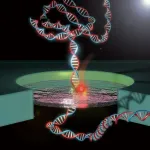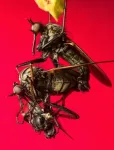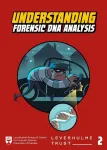(Press-News.org) PITTSBURGH, Feb. 5, 2025 – A new drug-free, minimally invasive intervention targets the root cause of progressive loss of neural function in spinal muscle atrophy (SMA), an inherited neuromuscular disease. An intervention, which involves electrical stimulation of the sensory spinal nerves, can gradually reawaken functionally silent motor neurons in the spinal cord and improve leg muscle strength and walking in adults with SMA. The findings were reported by University of Pittsburgh School of Medicine researchers in Nature Medicine today.
Early results from a pilot clinical trial in three human volunteers with SMA show that one month of regular neurostimulation sessions improved motoneuron function, reduced fatigue and improved strength and walking in all participants, regardless of the severity of their symptoms. The study is first to show that a neurotechnology can be engineered to reverse degeneration of neural circuits and rescue cell function in a human neurodegenerative disease.
“To counteract neurodegeneration, we need two things – stop neuron death and restore function of surviving neurons,” said co-corresponding author Marco Capogrosso, Ph.D., assistant professor of neurosurgery at Pitt. “In this study we proposed an approach to treat the root cause of neural dysfunction, complementing existing neuroprotective treatments with a new approach that reverses nerve cell dysfunction.”
SMA is a genetic neurodegenerative disease that manifests in progressive death and functional decline of motor neurons -- nerve cells that control movement by transmitting signals from the brain and the spinal cord to the muscles. Over time, the loss of motor neurons causes gradual muscle weakness, and leads to a variety of motor deficits, including for the participants in this trial, difficulty in walking, climbing stairs and standing up from chairs.
While there is no cure for SMA, several promising neuroprotective treatments have become available in the last decade. These include gene replacement therapies and medications, both of which stimulate the production of motoneuron-supporting proteins that prevent neuronal death and that slow down – though do not reverse – disease progression.
Studies show that movement deficits in SMA emerge before widespread motoneuron death, suggesting that underlying dysfunction in spinal nerve circuitry may contribute to disease onset and symptom development. According to earlier research on animal models of SMA by study co-author George Mentis, Ph.D., at Columbia University, surviving motor neurons receive fewer stimulation inputs from sensory nerves – fibers that return the information from skin and muscles back to the central nervous system. Compensating for this deficit in neural feedback could, therefore, improve communication between the nervous system and the muscles, aid muscle movement and combat muscle wasting.
Pitt researchers hypothesized that a targeted epidural electrical stimulation therapy could be used to rescue lost nerve cell function by amplifying sensory inputs to the motor neurons and engaging the degenerated neural circuits. These cellular changes could, in turn, translate into functional improvements in movement capacity.
The Pitt study was conducted as part of a pilot clinical trial that enrolled three adults with milder forms of SMA (Type 3 or 4 SMA). During a study period of 29 days, participants were implanted with two spinal cord stimulation (SCS) electrodes that were placed in the lower back region on each side of the spinal cord, directing the stimulation exclusively to sensory nerve roots. Testing sessions lasted four hours each and were conducted five times a week for a total of 19 sessions, until the stimulation device was explanted.
After confirming that the stimulation worked as intended and engaged spinal motor neurons, researchers performed a battery of tests to measure muscle strength and fatigue, changes in gait, range of motion and walking distance, as well as motoneuron function.
“Because SMA is a progressive disease, patients do not expect to get better as time goes on. But that is not what we saw in our study. Over the four weeks of treatment, our study participants improved in several clinical outcomes with improvements in activities of daily living. For instance, toward the end of the study, one patient reported being able to walk from their home to the lab without becoming tired,” said co-corresponding author Elvira Pirondini, Ph.D., assistant professor of physical medicine and rehabilitation at Pitt.
All participants increased their 6-Minute Walk Test score – a measure of muscle endurance and fatigue – by at least 20 meters, compared to a mean improvement of 1.4 meters over three months of comparable exercise regimen unaided by SCS and a median increase of 20 meters after 15 months of SMA-specific neuroprotective pharmacologic therapy.
These functional gains were mirrored by improved neural function, including a boost in motoneurons’ capacity to generate electrical impulses and transmit them to the muscles.
“Our results suggest that this neurostimulation approach could be broadly applied to treat other neurodegenerative diseases beyond SMA, such as ALS or Huntington’s disease, as long as appropriate cell targets are identified in the course of future research,” said co-corresponding author Robert Friedlander, M.D., chair of neurosurgery at Pitt and co-director of the UPMC Neurological Institute. “We are hoping to continue working with SMA patients and launch another clinical trial to test the long-term efficacy and safety of electrical spinal cord stimulation.”
Genis Prat-Ortega, Ph.D., Scott Ensel, B.S., and Serena Donadio, B.S., all of Pitt, are co-first authors of the study. Other authors of the study are Amy Boos, M.S., Jacqueline Ho, M.D., Sarah Frazier-Kim, Daryl Fields, M.D., Ph.D., Lee Fisher, Ph.D., Paula Clemens, M.D., and Peter Gerszten, M.D., all of Pitt; Luigi Borda, B.S., Prakarsh Yadav, B.S., Nikhil Verma, B.S., and Douglas Weber, Ph.D., all of Carnegie Mellon University; Tina Duong, Ph.D., of Stanford University; Jacqueline Montes, P.T., Ed.D., and George Mentis, Ph.D., of Columbia University; Steven Weinstein, Mikael Eliasson, of Genentech Roche; and Karen S. Chen, of the Spinal Muscular Atrophy Foundation.
This research was supported by an exploratory research grant from F. Hoffmann–La Roche. Genentech, Inc. (a member of the Roche Group) and the University of Pittsburgh hold rights to IP related to this study. Marco Capogrosso, Genis Prat-Ortega and Mikael Eliasson hold patent applications that relate to this work.
END
Spinal cord stimulation restores neural function, targets key feature of progressive neurodegenerative disease
2025-02-05
ELSE PRESS RELEASES FROM THIS DATE:
Shut the nano gate! Electrical control of nanopore diameter
2025-02-05
Osaka, Japan—A gate that can be open or shut to allow or block the passing of species on one or both sides applies not only on the macroscale, for example a farm gate used to control stock movement, but also at the nanoscale, where a gate can control the translocation of single molecules.
A collaboration headed by researchers at Osaka University has developed a nanogate that can be open or shut by applying electricity. The nanogate shows various behaviors depending on the materials in the solutions on both sides of the gate and the applied voltage, making it attractive for different applications including sensing and controlled chemical reactions.
The ...
Cutting emissions in buildings and transport: Key strategies for 2050
2025-02-05
Key findings: a roadmap to transform energy use by 2050
Electrification (e.g., switching to electric vehicles, heat pumps) alone could cut direct emissions by 45-77% in buildings and 22-86% in transport by 2050.
Combining electrification, efficiency improvements, and behavioral changes could reduce emissions even further: 51-85% for buildings and 37-91% for transport by 2050.
A multi-strategy approach would lower overall electricity demand by 8-33% per year, making the transition more cost-effective ...
How parents can protect children from mature and adult content
2025-02-05
Toronto, ON – As children's screen time continues to rise, so does their exposure to age-inappropriate content, including R-rated movies and violent video games. A new study published in BMC Pediatrics underscores the critical role parents play in shaping their children’s media consumption.
As child media consumption increases along with their exposure to mature media content, a new study finds that parent media practices play a key role in shaping preteens’ consumption of mature video games and R-rated movies.
Researchers found that parents’ own screen habits—such as using screens in front of their children and allowing screens during meals ...
By studying neutron ‘starquakes’, scientists hope to transform their understanding of nuclear matter
2025-02-05
The study of ‘starquakes’ (like earthquakes, but in stars) promises to give us important new insights into the properties of neutron stars (the collapsed remnants of massive stars), according to new research led by the University of Bath in the UK.
Such explorations have the potential to challenge our current approaches to studying nuclear matter, with important impacts for the future of both nuclear physics and astronomy. Longer term, there may also be implications in the fields of health, security and energy.
The value of studying asteroseismology – as these vibrations and flares are known – has emerged from research carried ...
Mouth bacteria may hold insight into your future brain function
2025-02-05
The bacteria in your mouth and on your tongue may be linked to changes in brain function as you age, new research suggested.
The study, led by the University of Exeter, found that certain bacteria were associated with better memory and attention, while others were linked to an increased risk of Alzheimer’s disease.
The researchers identified two possible ways these bacteria may impact brain health. This includes harmful bacteria directly entering the bloodstream, potentially causing damage to the brain. Alternatively, an imbalance between beneficial and harmful bacteria can reduce the conversion of ...
Is cellular concrete a viable low-carbon alternative to traditional concrete for earthquake-resistant structures?
2025-02-05
Investigators have found that a product called cellular concrete may be an environmentally friendly alternative to conventional concrete for constructing earthquake-resistant buildings.
In research published in Structural Concrete, the team analyzed the environmental impact of constructing a seven-story archetype residential building in Quito-Ecuador with cellular concrete, which is produced by incorporating a foaming agent that generates air pockets within the concrete matrix to decrease the material’s density while maintaining sufficient structural ...
How does light affect citrus fruit coloration and the timing of peel and flesh ripening?
2025-02-05
Citrus fruit rind color has long been used as an indicator of ripeness, but for some fruits such as mandarin fruit in the Chongqing region of China, the peel and flesh do not ripen synchronously, with the flesh usually reaching maturity while the peel is still green. This is a characteristic that seriously affects its commercial value. In new research published in the Journal of the Science of Food and Agriculture, investigators have discovered how red and blue LED light can stimulate color change in mandarin fruit.
Experiments showed that this light exposure causes ...
Male flies sharpened their eyesight to call the females' bluff
2025-02-05
With bloated bellies and hairy legs, female flies try to look bigger to get food from courting mates. But male flies, in turn, have sharpened their eyesight to call their bluff. A new study by researchers from the Universities of Gothenburg and Stockholm suggests that this is an ongoing evolution where both sexes try to outsmart each other.
For the first time, researchers have been able to show that also males can develop traits that help them pass on their genes despite the manipulative adaptations of the opposite sex. In different species of dance flies, there is a clear correlation between how richly decorated the female ...
School bans alone not enough to tackle negative impacts of phone and social media use
2025-02-05
Students attending schools that ban the use of phones throughout the school day aren’t necessarily experiencing better mental health and wellbeing, as the first worldwide study of its kind has found that just banning smartphones is not enough to tackle their negative impacts.
In a landmark study published today (Wednesday 5 Feb) in Lancet Regional Health Europe, 1227 students from 30 schools across England provided data about smartphone and social media usage and a range of mental health, wellbeing and other outcomes. ...
Explaining science in court with comics
2025-02-05
Imagine being summoned as a juror in a murder trial. The expert responsible for analyzing DNA traces at the crime scene has just explained that they match the defendant’s profile. “Then the culprit must be them,” you think. At this point, however, the expert adds: “The sample, however, is partially degraded.” What does this mean? How does this information affect your judgment? The scientist further explains that there is a one-in-a-billion probability that other people could match the identified genetic profile. ...





